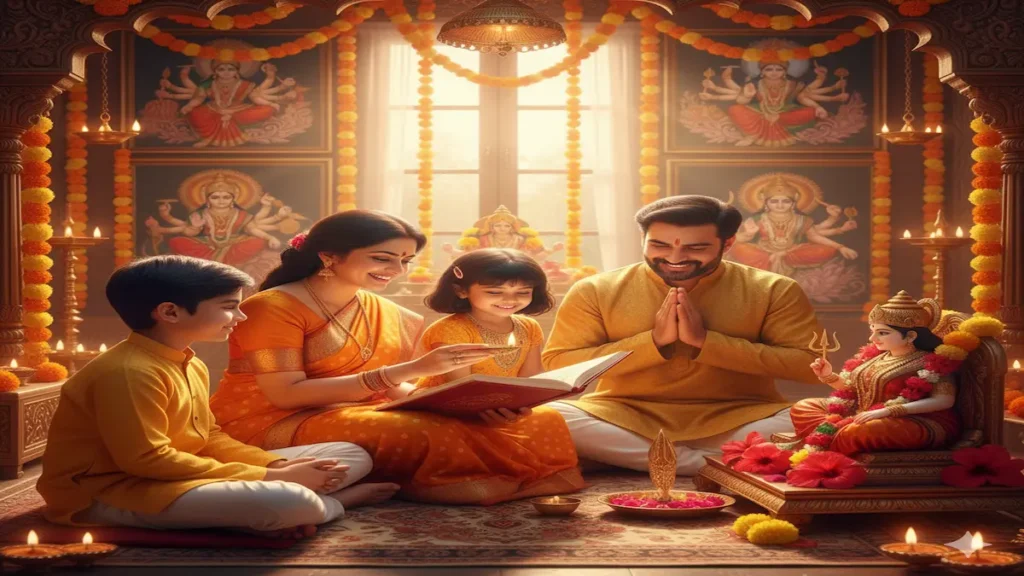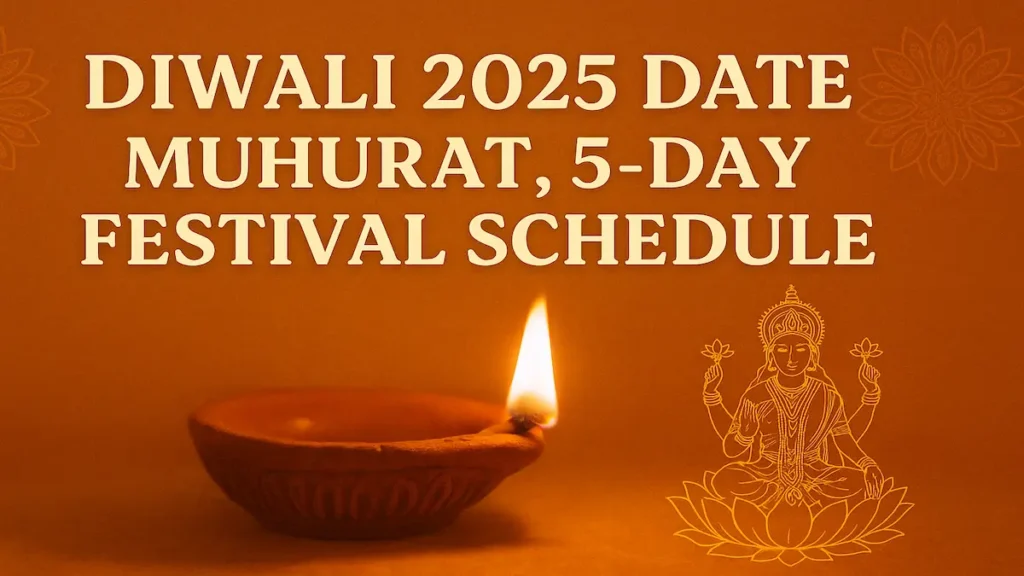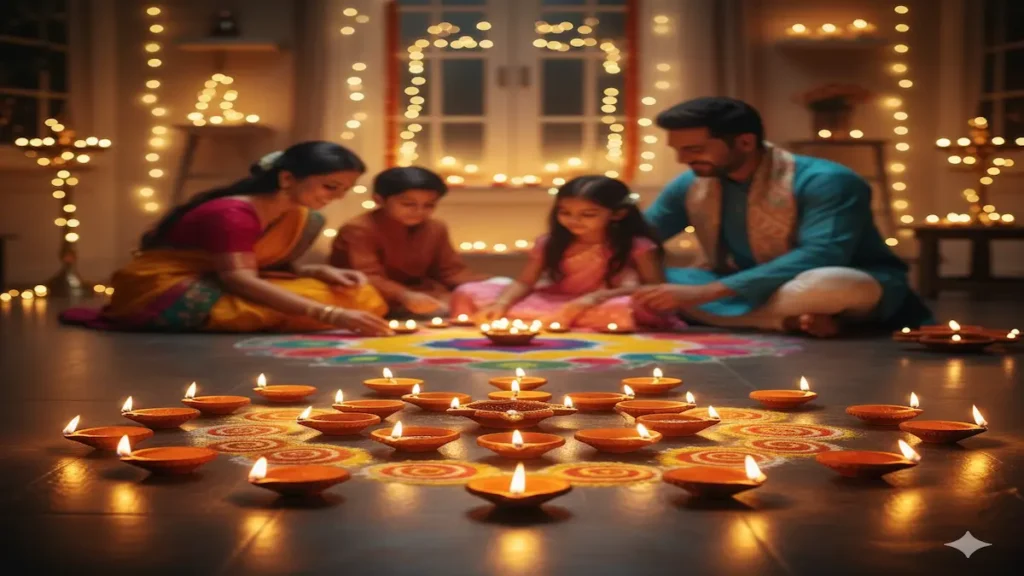Author: BhaktiParv.com
Introduction
Navratri is one of the grandest and most spiritual festivals in Hindu culture, celebrated over nine nights and ten days in honor of Goddess Durga and her nine divine forms. The festival symbolizes the eternal victory of good over evil and the divine feminine power that sustains the universe.
In 2025, devotees worldwide will once again welcome Navratri with devotion, fasting, traditional music, and prayers to honor the goddess who protects humanity from negativity and evil forces.
The word “Navratri” comes from Sanskrit, where “Nav” means nine and “Ratri” means night. These nine nights are dedicated to different forms of Devi Durga, each representing distinct powers, virtues, and blessings.
Navratri 2025 Dates and Schedule
In 2025, Shardiya Navratri will start on Tuesday, September 23, 2025, and end on Wednesday, October 1, 2025. These days are considered highly auspicious for spiritual practices, prayers, and self-purification.
Here’s the complete day-wise schedule for Navratri 2025:
| Day | Date | Navratri Tithi | Goddess Form |
|---|---|---|---|
| Day 1 | September 23 | Pratipada | Maa Shailputri |
| Day 2 | September 24 | Dwitiya | Maa Brahmacharini |
| Day 3 | September 25 | Tritiya | Maa Chandraghanta |
| Day 4 | September 26 | Chaturthi | Maa Kushmanda |
| Day 5 | September 27 | Panchami | Maa Skandamata |
| Day 6 | September 28 | Shashti | Maa Katyayani |
| Day 7 | September 29 | Saptami | Maa Kalaratri |
| Day 8 | September 30 | Ashtami | Maa Mahagauri |
| Day 9 | October 1 | Navami | Maa Siddhidatri |
Dussehra (Vijayadashami) will be observed on Thursday, October 2, 2025, marking the triumph of Lord Rama over Ravana, symbolizing victory of truth and righteousness.
Spiritual Significance of Navratri
Navratri is not just a festival; it’s a deep spiritual journey. It represents the nine stages of human growth and the gradual transformation of the soul from ignorance to wisdom.
According to Hindu scriptures, Goddess Durga fought the demon Mahishasura for nine days and nights, finally defeating him on the tenth day — celebrated as Vijayadashami.
These nine days remind devotees to eliminate negative qualities like anger, greed, and ego and to fill life with positivity, love, and devotion.
During Navratri, devotees also keep fasts, meditate, chant Durga Mantras, and participate in rituals that connect them to divine energy.
The 9 Forms of Goddess Durga (Navdurga)
Each of the nine forms of Durga, known as Navdurga, represents a unique power and energy that guides devotees toward spiritual fulfillment and worldly success.
1. Maa Shailputri (Daughter of the Mountain)
The first form of Durga, Maa Shailputri, symbolizes purity and devotion. Riding a bull and carrying a trident, she represents the foundation of strength and courage in life.
2. Maa Brahmacharini
She is the goddess of wisdom, discipline, and meditation. Devotees worship her to gain peace of mind, self-control, and spiritual enlightenment.
3. Maa Chandraghanta
Known for her third-eye and crescent moon on her forehead, she radiates bravery and serenity. She destroys evil and blesses devotees with fearlessness.
4. Maa Kushmanda
Called the creator of the universe, she brings energy and vitality to the world. Worshipping her grants good health, confidence, and positivity.
5. Maa Skandamata
Mother of Lord Kartikeya, she signifies maternal love and compassion. Her blessings bring success, happiness, and harmony in family life.
6. Maa Katyayani
The warrior form of Durga, born to sage Katyayan, she destroyed the demon Mahishasura. Devotees pray to her for courage, strength, and victory over obstacles.
7. Maa Kalaratri
Known as the fiercest form, she destroys darkness and evil. She removes fears, negative energies, and protects devotees from harm.
8. Maa Mahagauri
Symbol of calmness and purity, she represents forgiveness and peace. Worshipping her removes sins and grants spiritual enlightenment.
9. Maa Siddhidatri
The ninth and final form, she grants spiritual powers and fulfills all wishes. Devotees seek her blessings for perfection and divine wisdom.
How Navratri Is Celebrated Across India
Navratri celebrations vary by region, reflecting India’s rich diversity and cultural heritage:
- North India: Devotees observe fasts, recite Durga Saptashati, and perform Kanya Pujan (worship of young girls) on Ashtami or Navami. Ramleela performances and Ravan Dahan are common sights.
- West India: In Gujarat and Maharashtra, people celebrate with colorful Garba and Dandiya Raas dances, representing devotion and joy.
- South India: Families create Golu doll displays, hold bhajans, and share prasad, signifying divine creativity and harmony.
- East India: The festival culminates as Durga Puja, especially in West Bengal, Odisha, and Assam, with grand idols, rituals, and cultural performances.
No matter the region, the essence remains the same — worshipping the divine mother with pure heart and devotion.
Spiritual and Personal Benefits of Navratri Fasting
Fasting during Navratri is not just about food abstinence — it’s a holistic detox of mind and body.
Here are some key benefits:
- Cleanses the body and improves digestion
- Enhances focus and discipline
- Removes negative thoughts
- Promotes calmness and gratitude
- Strengthens connection with divine energy
Many devotees also follow a Satvik diet — consuming fruits, milk, and natural foods — which supports spiritual purity and health.
Navratri and Modern Life
Even in modern times, Navratri holds great relevance. It teaches us to stay balanced, positive, and strong amidst life’s challenges.
The festival inspires mindfulness, discipline, and the celebration of feminine power in all forms — from nature to nurturing relationships.
For working professionals, students, and families, Navratri becomes a time to reset, reconnect with faith, and recharge spiritually.
FINAL THOUGHTS
Navratri 2025 is more than a religious celebration — it’s a divine reminder that light always triumphs over darkness. As the nine nights unfold, may Goddess Durga bless your home with happiness, strength, and wisdom.
Celebrate this Navratri with faith, joy, and devotion, and let the divine energy guide you towards success and peace. 🌼
Q1. When is Navratri 2025 celebrated?
A1. In 2025, Shardiya Navratri will begin on Tuesday, September 23, 2025, and end on Wednesday, October 1, 2025. The festival lasts for nine nights and ten days, ending with Dussehra (Vijayadashami) on October 2, 2025. These days are considered highly auspicious for worshipping the nine forms of Goddess Durga.
Q2. What is the significance of Navratri?
A2. Navratri symbolizes the victory of good over evil and the worship of the divine feminine energy (Shakti). It commemorates Goddess Durga’s victory over the demon Mahishasura. Spiritually, it’s a time for self-purification, discipline, and devotion, helping devotees remove negativity and invite peace and strength into their lives.
Q3. What are the 9 forms of Goddess Durga worshipped during Navratri?
A3. The nine forms of Goddess Durga, also known as Navdurga, are:
Maa Shailputri
Maa Brahmacharini
Maa Chandraghanta
Maa Kushmanda
Maa Skandamata
Maa Katyayani
Maa Kalaratri
Maa Mahagauri
Maa Siddhidatri
Each form represents a distinct aspect of divine energy and grants unique blessings to devotees.
Q4. How is Navratri celebrated across India?
A4. Navratri is celebrated with devotion and joy throughout India. In North India, devotees fast and perform Kanya Pujan; in West India, people dance Garba and Dandiya Raas; South India observes Golu doll displays; and East India celebrates it as Durga Puja with grand rituals and processions.
Q5. What are the benefits of fasting during Navratri?
A5. Fasting during Navratri helps cleanse the body, improve digestion, and increase mental focus. Spiritually, it promotes discipline, inner peace, and devotion. Devotees also follow a Satvik diet — eating fruits, milk, and light meals to maintain purity and positivity.
Q6. Why do people perform Garba and Dandiya during Navratri?
A6. Garba and Dandiya Raas are traditional dance forms performed to honor Goddess Durga. The circular movements of Garba symbolize the cyclic nature of life — birth, preservation, and destruction — just like the cosmic energy of Maa Durga. These dances spread joy and unity during the festival.
Q7. What is the spiritual message of Navratri 2025?
A7. Navratri 2025 reminds us to conquer inner demons like anger, ego, and greed. It teaches that with faith, courage, and devotion, we can overcome all obstacles. The festival encourages harmony, gratitude, and the celebration of divine feminine strength in every aspect


